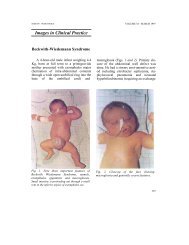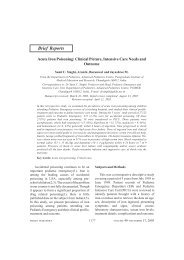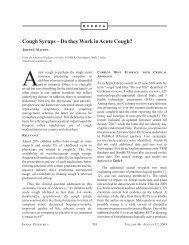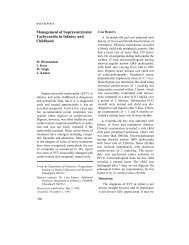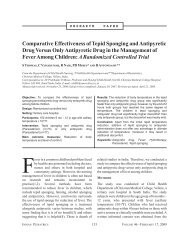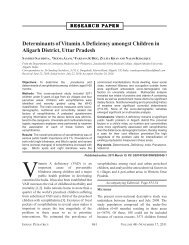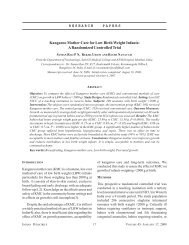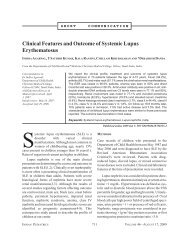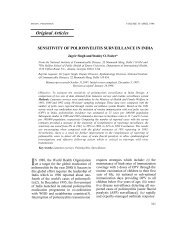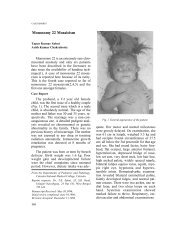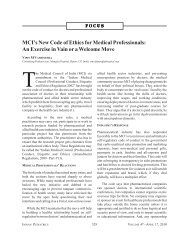Editorial - Indian Pediatrics
Editorial - Indian Pediatrics
Editorial - Indian Pediatrics
Create successful ePaper yourself
Turn your PDF publications into a flip-book with our unique Google optimized e-Paper software.
<strong>Editorial</strong><br />
MEDICAL THERAPY TO<br />
THE FETUS<br />
The human fetus has for centuries remained<br />
a medical recluse in an opaque<br />
womb. The concept of the fetus as a patient<br />
is alarmingly modern, as in earlier days<br />
there were no diagnostic or therapeutic<br />
measures available to assess the severity of<br />
fetal involvement, until after delivery.<br />
Experience in the management of fetal disorders<br />
is limited and the optimal management<br />
of each disorder is still in evolution.<br />
Opinion about the treatment of each fetal<br />
problem must hence be tentative and open<br />
to revision in relation to rapidly growing<br />
knowledge and experience.<br />
For decades drugs and other agents have<br />
been administered to pregnant women for<br />
treatment of fetal disorders in the hope<br />
of improving postnatal adaption(l). The<br />
Rhesus iso-immunization model provides a<br />
successful illustration of medical intervention<br />
in the developing fetus(2). This article<br />
highlights some of the established modes of<br />
medical therapy for the fetus.<br />
1. Prevention of Respiratory Distress<br />
Syndrome (RDS)<br />
The pioneering work of Francis Moog<br />
led to the observation that glucocorticoids<br />
were capable of accelerating developmental<br />
process in the mammalian lung. Liggins observed<br />
that when glucocorticoids triggered<br />
the onset of labor in pregnant sheep, the<br />
lamb born prematurely had well aerated<br />
lungs, while a large number of control animals<br />
died of RDS. Subsequently, a number<br />
of prospective studies(3-5) were unanimous<br />
in their observation that exogenously<br />
administered glucocorticoids significantly<br />
decreased the incidence of RDS in preterms<br />
below 34 weeks gestation. The mode<br />
of glucocorticoid action is believed to be<br />
either increased release of surfactant from<br />
granules in alveolar type II cells or by<br />
increasing lecithin synthesis.<br />
In a study recently concluded by us at<br />
the Wadia Maternity Hospital in Bombay<br />
(data under publication), cord blood cortisol<br />
levels were estimated in preterms (
EDITORIAL<br />
(total dose 25-50 mg over 3 to 5 days) is the<br />
most effective schedule in neonates without<br />
hemolytic disease(7). From the practical<br />
viewpoint this schedule may be suitable for<br />
the management of preterm labor and<br />
threatened delivery. NO significant difference<br />
in neonatal behavior pattern has been<br />
reported following intrapartum exposure to<br />
this drug(8).<br />
3. Prevention of Fetal Growth Retardation<br />
with Low Dose Aspirin Therapy<br />
The efficacy of aspirin in the prevention<br />
of arterial thrombosis has been known for<br />
many years. Several studies have shown<br />
that low dose aspirin (50-150 mg/day) can<br />
prevent eclampsia and fetal growth retardation(9,<br />
10). This effect of aspirin is linked to<br />
its action of inhibiting thromboxane production<br />
in the human placenta. Results of the<br />
EPREDA trial(9) revealed that the mean<br />
birth weight of neonates born to mothers<br />
who received low dose aspirin from 20<br />
weeks gestation till delivery was 200-225 g<br />
higher than those whose mothers had<br />
received a placebo.<br />
Aspirin does not increase the overall<br />
risk of fetal malformations, nor increases<br />
the risk to abnormal bleeding in the neonate<br />
or the risk to premature closure of fetal ductus<br />
arteriosus(ll). Thus, there has been no<br />
evidence as yet that low dose aspirin poses<br />
any risk to the mother of fetus. Although<br />
preliminary data with this drug is encouraging,<br />
only large multicentric study data will<br />
finally ascertain both the safety and efficacy<br />
of this modality of therapy.<br />
4. Prenatal Vitamin K Supplementation<br />
to Prevent Neonatal Hemorrhagic<br />
Disease<br />
Newborns, particularly preterms and<br />
those exposed to anticonvulsant or antitu-<br />
berculous therapy in utero show a bleeding<br />
tendency because of vitamin K deficiency.<br />
Recent reports(12,13) have suggested that<br />
vitamin K 1 , (phylloquinone) crosses the placenta.<br />
Thus adequate dosage and duration of<br />
oral vitamin K 1 therapy to pregnant women<br />
could replace prophylaxis with vitamin K<br />
injection at birth and may be effective in the<br />
prevention of both early (within 48 hours of<br />
birth) and classic hemorrhagic disease. Oral<br />
vitamin K 1 prenatally administered in daily<br />
doses of 10 mg for 10-15 days activates<br />
vitamin K dependant coagulation factors for<br />
atleast the first 5 days of postnatal life.<br />
Thus, oral prenatal vitamin K 1 therapy may<br />
replace prophylaxis with parenteral vitamin<br />
K to the newborn.<br />
5. Prenatal Management of Immune<br />
Fetal Anemia<br />
Fetal hydrops due to rhesus-isoimmunization<br />
induced hemolysis has been successfully<br />
treated by transfusing red blood<br />
cells into the fetus. The older practice of<br />
infusing red cells into the fetal peritoneal<br />
cavity(14) has been largely replaced in<br />
favor of the physiologically more correct<br />
mode of intravascular transfusion. This is<br />
done by percutaneous umbilical cord puncture<br />
and blood directly injected into the<br />
fetal vascular system through the umbilical<br />
vein(15-17). The procedure is usually<br />
attempted around 24-26 weeks of gestation<br />
and repeated at 10-15 days intervals till the<br />
fetus reaches a stage of maturity when safe<br />
delivery and neonatal survival becomes a<br />
reality, which is at an approximate gestational<br />
age of 34 weeks(18).<br />
The procedure was first popularized by<br />
Rodeck(16) and subsequently with greater<br />
success and less fetal trauma by Nicolaides<br />
et al.(17). 'O' rhesus negative blood packed<br />
to a hematocrit of approximately 70-75%<br />
760
INDIAN PEDIATRICS<br />
and previously cross matched with mothers'<br />
serum is slowly infused into the umbilical<br />
vein while a close watch is kept on the fetal<br />
heart rate. The exact volume of blood to be<br />
transfused is estimated from a normogram<br />
which takes into consideration the pretransfusion<br />
hematocrit of fetal blood, the donor<br />
hematocrit, the expected hematocrit to be<br />
achieved, as also the fetal gestation(19).<br />
Our experience at the Wadia Hospital<br />
with 8 such severely sensitized 'Rh' negative<br />
women whose fetuses had received a<br />
total of 28 ultrasound guided intrauterine intravascular<br />
transfusions into the umbilical<br />
vein between 25 to 33 weeks gestation has<br />
been extremely encouraging. The volume of<br />
blood we have transfused at a time ranged<br />
from 50 to 200 ml and the transfusion time<br />
from 30 to 60 minutes. Pre and post transfusion<br />
hematocrit was determined in all cases.<br />
Procedural problems that we encountered<br />
were transient fetal bradycardia in four instances,<br />
and difficulty in umbilical vein<br />
cannulation on two occasions. All but one<br />
baby were delivered by elective cesarean<br />
section between 34-36 weeks gestation. One<br />
baby delivered spontaneously vaginally at<br />
28 weeks gestation and expired of severe<br />
HMD and one expired of DIC. Our procedural<br />
mortality was nil, however postnatally<br />
2 of 8 (25%) expired.<br />
6. Antenatal Medical Management of<br />
Metabolic Defects<br />
(a) Congenital Adrenal Hyperplasia<br />
(CAH): Evans et al. first demonstrated that<br />
the fetal adrenal gland can be suppressed<br />
pharmacologically by maternal replacement<br />
doses of dexamethasone(20), and that this<br />
helped to prevent external genital masculinization<br />
of female fetuses affected with severe<br />
form of 21 hydroxylase deficient CAH.<br />
Several such female infants with CAH who<br />
VOLUME 31- JULY 1994<br />
would have been masculinized have been<br />
born with normal female genitalia after this<br />
form of fetal therapy. With the availability<br />
of a probe for the gene and the advent of<br />
first trimester chorionic villus sampling, a<br />
definitive diagnosis of an affected fetus is<br />
usually possible by DNA analysis of the<br />
chorionic villi before initiation of therapy.<br />
The current recommended protocol is to<br />
start dexamethasone 0.25 mg qid, at 7-8<br />
weeks gestation and to perform fetal sexing<br />
and DNA analysis at 9-10 weeks. If the<br />
fetus is an affected female, then therapy is<br />
continued throughout gestation, whereas if<br />
the fetus is a male or is unaffected, then s<br />
maternal steroids are tapered off(21).<br />
(b) Multiple Carboxylase Deficiency<br />
and Methylmalonic Acidemia: These metabolic<br />
defects related to Biotin and vitamin.<br />
B 12 deficiency, respectively, are known to<br />
cause severe neonatal metabolic acidosis,<br />
brain damage and may even be fatal(22).<br />
Both these disorders can be diagnosed antenatally<br />
and can be treated with large doses n<br />
of biotin 10 mg/day or vitamin B 12 10 mg/<br />
day for the respective disorders. Whether<br />
there is any significant clinical benefit to<br />
the fetus by in utero treatment cannot be<br />
adequately assessed, but it seems likely that<br />
reducing the fetal burden should have some<br />
beneficial effect on fetal development and<br />
possibly reduce risks in the neonatal<br />
period(23,24).<br />
(c) Galactosemia: An inborn error of<br />
galactose metabolism inherited in an<br />
autosomal recessive manner that results in<br />
cataracts, hepatitis, growth and ovarian<br />
failure, U can be diagnosed antenatally<br />
by studying is cultured chorionic villi.<br />
The disorder is treated postnatally by<br />
eliminating galactose from the diet;<br />
however, irreversible damage can occur to<br />
the ovaries long before birth(25).<br />
There has been speculation that<br />
761
EDITORIAL<br />
prenatal damage to the galactosemic fetus<br />
could contribute to subsequent abnormal<br />
CNS development and the female fetus may<br />
have higher incidence of amenorrhea and<br />
ovarian insufficiency. These observations<br />
have led to the speculation that galactose restriction<br />
during pregnancy may be desirable<br />
if the fetus is affected with galactosemia.<br />
Thus, anticipatory treatment in pregnancies<br />
at risk for having a galactosemic fetus must<br />
be initiated early in gestation or even preconceptially(26).<br />
There is little reason to<br />
believe that galactose restriction would<br />
have adverse consequences as the fetus<br />
is capable of some endogenous galactose<br />
synthesis.<br />
7. Treatment of Fetal Cardiac Arrhythmias<br />
Supraventricular tachycardia (SVT) is<br />
known to cause cardiac failure in utero and<br />
may lead to hydrops and death(27). Although<br />
an extremely uncommon disorder, it<br />
can be successfully treated by administration<br />
of digitalis to the mother(28). The drug<br />
crosses the placenta into the fetus and<br />
converts the SVT into a normal rate and<br />
rhythm, thereby salvaging the fetus from a<br />
potentially fatal outcome(29). Propranalol<br />
has also been used for the same purpose as a<br />
second drug of choice; however, it places<br />
the fetus at risk for hypoglycemia, bradycardia<br />
and depressed Apgar scores(30). Our experience<br />
in the treatment of fetal SVT is<br />
limited to the management of two cases,<br />
both of whom responded dramatically to the<br />
administration of maternal digoxin and in<br />
whom postnatal digoxin therapy was not required.<br />
The etiology of the fetal SVT in<br />
both these cases could; however, not be<br />
established.<br />
Medical treatment has until now been<br />
largely directed at transplacental drug<br />
administration with the aim of creating<br />
pharmacological alterations in the fetus.<br />
The disadvantages of transplacental treatment<br />
are: (a) placental transfer depends on<br />
the degree of maternal absorption and excretion<br />
of the drug; and (b) direct monitoring<br />
of fetal drug level is not feasible.<br />
There is also a subset of fetal states in<br />
which something vital to fetal wellbeing is<br />
not present in sufficient quantity and supplementing<br />
the missing substance would<br />
constitute the essence of medical therapy.<br />
The list of substances that may be given<br />
therapeutically to the fetus in utero is certain<br />
to grow. For example it may be possible<br />
in the near future to treat the growth retarded<br />
fetus by instilling nutrients into the<br />
amniotic fluid(31) or even to administer<br />
thyroid hormone in this fashion.<br />
There has been a considerable sobering<br />
of the initial wave of enthusiasm surrounding<br />
fetal surgical intervention and medical<br />
and pharmacological alterations in the melieu<br />
of the fetus now appears to be more<br />
promising and ultimately is likely to be the<br />
mainstay of fetal therapy(l). Our ability to<br />
diagnose a number of fetal disorders has<br />
achieved considerable sophistication. The<br />
treatment of several of these fetal conditions<br />
has now proven feasible and the treatment<br />
of more complicated disorders will expand<br />
as techniques and our knowledge improves.<br />
The fetus could not be considered a patient<br />
until it was demystified and since then<br />
it has come a long way from the biblical<br />
"seed" to an individual with medical problems<br />
that can be diagnosed and treated.<br />
Although the fetus seldom complains, he<br />
occasionally needs a physician, and the possibility<br />
of treating certain fetal disorders before<br />
birth gives an entirely new meaning to<br />
prenatal diagnosis. The possibility of fetal<br />
762
INDIAN PEDIATRICS<br />
therapy raises complex ethical questions<br />
about risks and benefits and about the rights<br />
of the mother and fetus as patients. We are<br />
only beginning to address some of these difficult<br />
areas(32).<br />
R.H. Merchant,<br />
Neonatologist, Wadia Maternity<br />
Hospital and In-charge Neonatal Services,<br />
Wadia Children's Hospital,<br />
Parel, Bombay 400 014.<br />
REFERENCES<br />
1. Evans MI, Schulman JD. Biochemical Fetal<br />
therapy. Clin Obstet Gynecol 1986, 29:<br />
523-530.<br />
2. Bowman JM. The management of Rh-isoimmunization.<br />
Obstet Gynecol 1978, 52:<br />
1-15.<br />
3. Liggins GC, Howie RN. A controlled trial<br />
of antepartum glucocorticoid treatment<br />
for prevention of RDS in premature<br />
infants. <strong>Pediatrics</strong> 1972, 50: 515-525.<br />
4. Caspi E, Schreyer P, Weinraub Z, et al.<br />
Prevention of respiratory distress syndrome<br />
in premature infants by antepartum<br />
glucocorticoid therapy. Br J Obstet Gynecol<br />
1976, 83: 187-193.<br />
5. Doren TA, Swyer P, McMurray A, et al.<br />
Results of double blind controlled study<br />
on the use of betamethasone in the prevention<br />
of RDS. Am J Obstet Gynecol<br />
1980, 136: 313-320.<br />
6. Trolle D. Phenobarbitone and neonatal<br />
jaundice. Lancet 1968, 1: 251-252.<br />
7. Wallin A, Boreus LO. Phenobarbital prophylaxis<br />
for hyperbilirubinemia in preterm<br />
infants. Acta Pediatr Scand 1984, 73:<br />
488-490.<br />
8. Valaes T, Kipouros K, Petmezaki S, et al.<br />
Effectiveness and safety of prenatal phenobarbital<br />
for the prevention of neonatal<br />
jaundice. Pediatr Res 1980,14: 947-950.<br />
9. Uzan S, Beaufils M, Breart G, Bazin B,<br />
VOLUME 31-JULY 1994<br />
Capitant C, Paris J. Prevention of fetal<br />
growth retardation with low dose aspirin.<br />
Findings of the EPREDA trial. Lancet<br />
1991, 337: 1427-1431.<br />
10. Trudinger BJ, Cook CM, Thompson RS,<br />
Giles WB, Connelly A. Low dose aspirin<br />
therapy improves fetal weight in umbilical<br />
placental insufficiency. Am J Obstet<br />
Gynecol 1988, 159: 681-684.<br />
11. Sibai BM, Mirro R, Chesney CM, Leffler<br />
C. Low dose aspirin in pregnancy. Obstet<br />
Gynecol 1989, 74:551-557.<br />
12. Anai T, Hirota Y, Yoshimatsu J, Oga M,<br />
Miyakawa I. Can prenatal vitamin K 1<br />
(Phylloquinone) supplementation replace<br />
prophylaxis at birth? Obstet Gynecol<br />
1993, 81: 251-254.<br />
13. Lane PA, Hathaway WE. Vitamin K in<br />
infancy. J Pediatr 1985, 106: 351-359.<br />
14. Liley AW. Intrauterine transfusion of fetus<br />
in hemolytic disease. Br Med J 1963,<br />
2: 1107-1109.<br />
15. Berkowitz RL, Hobbins JC. Intrauterine<br />
transfusion utilizing ultrasound. Obstet<br />
Gynecol 1981, 57: 33-35.<br />
16. Rodeck CH, Nicolaides KH, Warsof SL,<br />
Fysh WJ, Gamsu HR, Kemp JR. The man<br />
agement of severe rhesus isoimmunization<br />
by fetoscopic intravascular transfu<br />
sions. Am J Obstet Gynecol 1984, 150:<br />
769-774.<br />
17. Nicolaides KH, Rodeck CH, Mibashan<br />
RS, Kemp RJ. Have Liley’s charts<br />
outlived their usefulness? Am J Obstet<br />
Gynecol 1986,155: 90-94.<br />
18. Whittle MJ. Rhesus hemolytic disease:<br />
Obstetrics for Pediatricians. Arch Dis<br />
Child 1992, 67: 65-68.<br />
19. Parer JT. Severe Rh isoimmunization.<br />
Current methods of in utero diagnosis and<br />
treatment. Am J Obstet Gynecol 1988,<br />
158: 1323-1329.<br />
20. Evans MI, Chrousos GP, Mann DL, et al.<br />
763
EDITORIAL<br />
Pharmacologic suppression of the fetal<br />
adrenal gland. Attempted prevention of 21<br />
hydroxylase insufficiency congenital adrenal<br />
hyperplasia in utero. JAMA 1985,<br />
253: 1015-1021.<br />
21. Forrest M, David M. Prenatal treatment of<br />
congenHal adrenal hyperplasia due to 21<br />
hydroxylase deficiency. Seventh International<br />
Congress of Endocrinology. Abst<br />
No. 911. Quebec, Canada, 1984.<br />
22. Packman S. Approach to inherited metabolic<br />
disorders presenting in the newborn<br />
period. In: <strong>Pediatrics</strong>, 17 th edn. Eds Rudolph<br />
AM, Haffman JCE, Norwalk, CT.<br />
Appleton-Century-Crofts, 1982, pp 256-<br />
259.<br />
23. Nyhan WL. Prenatal treatment of methylmalonic<br />
aciduria. N Engl J Med 1975,<br />
293: 353-354.<br />
24. Packman S, Cowan MJ, Golbus MS, et al.<br />
Prenatal treatment of biotin responsive<br />
multiple carboxylase deficiency. Lancet<br />
1982, 1: 1435-1439.<br />
25. Chen YT, Mattison DR, Feigenbaum L, et<br />
al. Reduction in oocyte number following<br />
prenatal exposure to a high galactose diet.<br />
Science 1981, 214: 1145-1147.<br />
26. Segal SS. Disorders of galactose metabo-<br />
lism. In: The Metabolic Basis of Inherited<br />
Disease, 5th edn. Eds Stanbury JB, Wyngarden<br />
JB, Frederickson DS. New York,<br />
McGraw Hill, 1983, p 167.<br />
27. Holzgreve W, Curry CJR, Golbus MS, et<br />
al. Investigations of non immune hydrops<br />
fetalis. Am J Obstet Gynecol 1984, 150:<br />
805-812.<br />
28. Kleinman CS, Copel JA, Weinstein EM,<br />
et al. In utero diagnosis and treatment of<br />
fetal supraventricular tachycardia. Semin<br />
Perinatol 1985, 9: 113-129.<br />
29. Gough JD, Keeling JW, Caste B, Iliff PJ.<br />
The obstetric management of non immunological<br />
hydrops. Br J Obstet Gynecol<br />
1986, 93: 226-234.<br />
30. Gladstone GR, Hardorf A, Gersony WM.<br />
Propranolol administration during pregnancy:<br />
Effect on fetus. J Pediatr 1975, 86:<br />
962-964.<br />
31. Saling E, Kynast G. A new way for the<br />
paraplacental supply of substances to the<br />
fetus. J Perinat Med Suppl 1981, 1: 144-<br />
145.<br />
32. Harrison MR, Filly RA, Golbus MS. Management<br />
of the fetus with a correctable<br />
congenital defect. JAMA 1981, 246: 774-<br />
780.<br />
764



